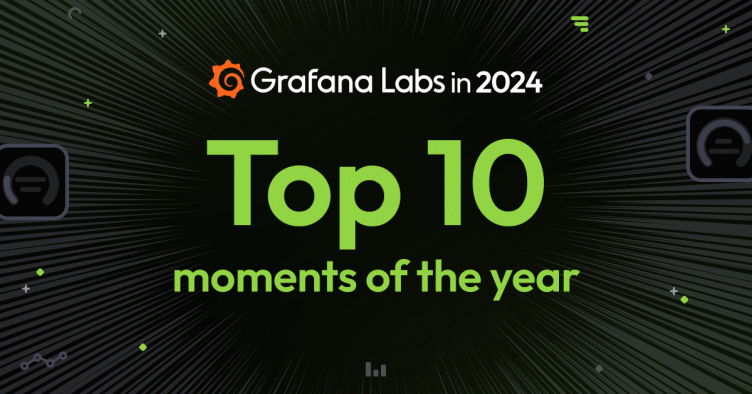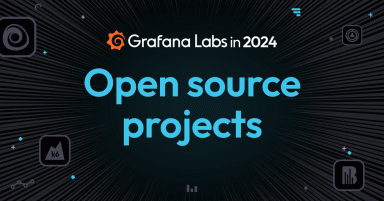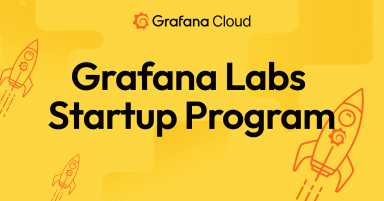
Grafana Labs: Top 10 moments of 2024
2024 was a year of making connections.
The open source community gathered in person for GrafanaCON for the first time in five years — meeting in Amsterdam to celebrate Grafana 11, Loki 3.0, a new open source project (cue Grafana Alloy), and more. TailCtrl, an early-stage company that specializes in adaptive trace sampling, joined Grafana Labs to advance our Adaptive Telemetry story (welcome, founder Sean Porter!). And we found exciting ways to make it easier for users to connect with their data, from query-free data analysis to launching new tools to help monitor multiple collectors (hello, Fleet Management).
Above all, we have loved finding new ways to reach the open source community this year — whether it’s through fresh discussions on “Grafana’s Big Tent” podcast, gauging the opinions of more than 300 practitioners in our second annual Observability Survey, or working with emerging observability companies through the Grafana Labs Startup Program.
“We really believe in the big tent, bringing together other projects, other ecosystems, other vendors all underneath Grafana, and helping you analyze your data no matter where it lives,” said Grafana Labs Co-founder and CEO Raj Dutt at GrafanaCON 2024, “and we are so privileged to be at the center of this really vibrant community and ecosystem.”
Here are some of the highlights of 2024 for Grafana Labs.
1. GrafanaCON in person, in Amsterdam
The last time the Grafana community gathered in person for GrafanaCON? 2019 in Los Angeles. “I gotta say, after three or four years of virtual GrafanaCONs, I’m kind of virtual-ed out,” said Grafana Labs CEO and co-founder Raj Dutt. But no matter if it’s in person or online, “my overwhelming emotion at every GrafanaCON is really excitement and gratitude.”
Same, Raj, same. Which is why it was thrilling to bring together about 400 attendees at GrafanaCON 2024 in Amsterdam for two days of community-led sessions, live demos, and hands-on workshops. (Sessions are available on demand today!) We also celebrated the release of Grafana 11, the winners of the second annual Golden Grot Awards, and the opportunity to reunite with the open source community.
Want to take part next year? Join us at GrafanaCON 2025 from May 6 - 8 in Seattle. The CFP is open, and we are accepting applications for the Golden Grot Awards.
2. Loki 3.0 release
Welcome to the next chapter of Grafana Loki! On the heels of the Loki project celebrating five years of growth and development, we rolled out Grafana Loki 3.0 at GrafanaCON in April.
The latest major release of our open source log aggregation system introduced:
- Accelerated query results. Bloom filters is an experimental feature intended to help return “needle in a haystack” queries faster. After working with early adopters and seeing how Bloom filters worked at scale, we decided to adjust our approach in Loki 3.3 to leverage structured metadata, making it faster to build, download, and query.
- Native OpenTelemetry support. Say good-bye to the Loki Exporter! Now that Loki has native OTel support, you get a simpler ingestion pipeline and a better querying experience since you can interact with all the OpenTelemetry attributes and log event metadata at query time without having to do any deserialization.
It was also a huge year of growing adoption for Loki, which saw installs climb from 64,000 in 2023 to 132,000 in 2024.
P.S. There’s still a few more weeks to go in the year, if you want to install Loki yourself!
3. Grafana Alloy launch
We welcomed a new open source project into the family and we are proud to announce: It’s a collector!
Wait, another collector?
Hear us out: Grafana Alloy is our open source distribution of the OpenTelemetry Collector. It’s 100% OTLP compatible and offers native pipelines for OpenTelemetry and Prometheus telemetry formats, supporting metrics, logs, traces, and profiles. (For those of you familiar with Grafana Agent Flow, Alloy will make you feel right at home because it uses the same components, code, and concepts.)
This open source tool combines all the observability signals that are vital to run combined infrastructure and application monitoring workloads at scale. Plus, it includes enterprise-grade features — such as native clustering for production at scale and built-in Vault support for enhanced security — all out of the box.
To learn more, check out our GrafanaCON session all about Alloy.
4. Adaptive Telemetry grows
Imagine an observability stack in which all the noise is pruned away and your team just retains the signal that matters, ensuring that every byte of data that you store is worth your money.
That’s the goal of Adaptive Telemetry, a set of tools that uses AI/ML to identify the signals you really need and extract them from the fire hose of observability data that you are maintaining.
This year we introduced Adaptive Logs, which analyzes your incoming data and compares it to your usage patterns to make a set of customized recommendations to help you reduce the volume of unnecessary logs to lower your observability costs. Our customers, our early adopters, and even our company have seen a decrease of 40% to 60% of total ingested log volume.
Adaptive Logs joins Adaptive Metrics, which aggregates unused and partially used metrics into lower cardinality versions, in our growing Adaptive Telemetry suite of tools. Soon Adaptive Traces will join the ranks thanks to Sean Porter, the founder of startups TailCtrl and Sensu, who joined Grafana Labs this year. TailCtrl specialized in adaptive trace sampling, which aligns with our Adaptive Traces goals. With Sean’s help, we hope to extend the Adaptive Telemetry functionality across the LGTM Stack, so you can more easily and cost-effectively analyze observability data at scale.
5. Celebrating 10 hackathons and counting
At Grafana Labs, our company-wide hackathon rules are simple: Grafanistas are encouraged to work in cross-collaborative teams to build anything as long as it helps solve a problem for the company or benefits the community. And you have a week to do it. “These Hackathons are so important,” says Grafana Labs Co-founder Anthony Woods. “We want to make sure that there is always an avenue for talented people across the company, not just in R&D, to innovate.”
The ideas sparked over 10 hackathons have been both inspiring and entertaining, with projects ranging from new Grafana visualizations like the candlestick panel to answering the pressing question of our time: Can Grafana run Doom? (Spoiler alert: It can!)
Almost 50% of our hackathon projects have either shipped, are on our roadmap, or are in progress. For example, Explore Logs, an app that lets you browse your logs without LogQL, started as a hackathon project and ended up being spotlighted at GrafanaCON. It now joins the powerful Explore apps suite, which is available in OSS and Grafana Cloud and includes Explore Metrics, Explore Traces, and Explore Profiles.
Update: As of Feb. 20, 2025, the Explore apps (Explore Metrics, Explore Logs, Explore Traces, Explore Profiles) are now the Drilldown apps (Metrics Drilldown, Logs Drilldown, Traces Drilldown, Profiles Drilldown).
6. Season 2 of ‘Grafana’s Big Tent’ podcast
Grafana Labs’ award-winning podcast, “Grafana’s Big Tent,” which is all about the people, community, tools, and tech around observability, returned for another season with more special guests, more observability insights, and an extended metaphor about restaurant seating and resource utilization that you never knew you needed.
With almost 6,000 downloads to date, season 2 has reached listeners around the world, from India to South Africa to Brazil and beyond, and touched on a wide array of topics, such as caching, optimization, and DDoS protection. “At Grafana Labs, it’s way more than just about the technology we build,” said Grafana Labs CTO Tom Wilkie in the introductory episode. “Grafana is one of the few pieces of software in the world that touches hundreds of different projects. And we want to use this platform we’ve got as a way of shining a spotlight on some of those projects.”
7. Extending the Grafana Cloud stack
We are consistently shipping new features for Grafana Cloud in an effort to make our cloud-hosted observability platform more efficient, more intelligent, and easier to use, especially for those just starting out on their observability journey.
This year is no exception, as we introduced or updated the following tools to make it even easier to optimize and troubleshoot your infrastructure and applications:
- Synthetic Monitoring for managing APIs and web applications from the user’s perspective.
- Cloud Provider Observability for monitoring multi-cloud environments.
- Fleet Management for monitoring collectors in your infrastructure.
- Asserts and Application Observability for AI/ML-powered root cause analysis for your backend services.
8. Industry recognition
It’s an honor just to be nominated, but we’re learning it feels great to be acknowledged as well. Grafana Labs was named a Leader in the Gartner® Magic Quadrant™ for Observability Platforms — one in a string of recognitions that shows how our company and community is playing a vital role in the area of modern software development management.
We were also thrilled to be included in:
- The Forbes Cloud 100 list, which recognizes the best private cloud computing companies; Grafana Labs ranked 23rd in 2024.
- The Silicon Valley Defense Group’s NATSEC100, which ranked Grafana Labs 23rd among “national security-focused and dual-use startups.”
- The InfraRed 100, an unranked list that honors transformative companies in cloud infrastructure.
- The 10 coolest open source software tools in 2024 and on the Big Data 100, both produced by CRN.
But even with all the shiny, new accolades, we still — and always will — consider your success to be the ultimate validation of our products. “We have customers big and small, from the largest top 10 companies in the world to startups and hobbyists using the free tier of Grafana Cloud,” Raj noted during GrafanaCON. “It’s great to see that growth.”
Update: Speaking of customers, we’re also proud that Grafana Labs was named a Customers’ Choice in the Dec. 2024 Gartner Peer Insights “Voice of the Customer”: Observability Platforms.
9. Observability Survey 2024
Regardless of the industry they operate in or the number of people they employ, businesses with mature observability practices can respond to incidents faster — and save time and money in the process, according to the second annual Observability Survey presented by Grafana Labs.
More than 300 observability practitioners participated in the second annual Observability Survey presented by Grafana Labs. They shared their thoughts on a wide range of topics, including the varying degrees of maturity, the sheer volume of tools in use, the lingering concerns about expenses, and the ubiquity of open source tools in this still-emerging market. What results is an in-depth look at the state of the industry today — and what practitioners hope to see in the future.
We’d love to hear from you! Take the 3rd annual Observability Survey today. It takes about five minutes and all responses will be kept anonymous.
10. Grafana Labs Startup Program
Startups face a particular set of challenges, especially when they have to scale rapidly. To alleviate some of the pressure on founders who are trying to keep up with demand while also keeping the lights on, we launched the Grafana Labs Startup Program, which includes up to $100,000 in Grafana Cloud credits to eligible startups for 12 months or until their next round of funding.
Thus far more than $1 million in Grafana Cloud credits have been provisioned to early stage startups with more to come. “Grafana Cloud’s solutions and open source approach gives us a ton of flexibility, and the startup program has allowed us to focus on execution without worrying about our monitoring stack,” said Julian Giuca, CEO of the telemetry management platform Datable.io, which is one of the first companies accepted in the program.
Interested in applying? Learn more about the Grafana Labs Startup Program.
Whew! All that and we still have two more weeks until the end of the year. All of our success wouldn’t be possible without the incredible open source community that we are so thankful to be part of day in and day out. We can’t wait to start the new year and find even more ways to connect with all of you.
Gartner® and Peer Insights™ are trademarks of Gartner, Inc. and/or its affiliates. All rights reserved. Gartner Peer Insights content consists of the opinions of individual end users based on their own experiences, and should not be construed as statements of fact, nor do they represent the views of Gartner or its affiliates. Gartner does not endorse any vendor, product or service depicted in this content nor makes any warranties, expressed or implied, with respect to this content, about its accuracy or completeness, including any warranties of merchantability or fitness for a particular purpose.



